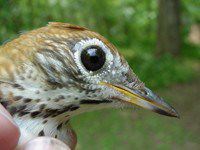|
|
|||
|
THIS WEEK at HILTON POND |
|
Here at Hilton Pond Center--in the heart of the Carolina Piedmont--we almost never get those big warbler migrations that always seem to occur elsewhere in the Carolinas. To make matters worse, for the past several years the peak of spring migration has not been accompanied by significant weather fronts that would cause warblers to "fall out" in sizable numbers. And, to complicate matters further, our ground-level mist nets don't catch many warbler species that hang out in the tree tops, so our banding results probably don't provide a true picture of which warblers actually move through the area. 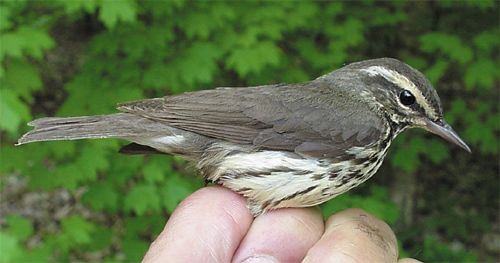 Warblers as a whole do take advantage of nearly every available habitat, however, and some do hang out below the canopy. Thus, we catch relatively good numbers of Black-throated Blue Warblers, Common Yellowthroats, and American Redstarts and are almost guaranteed in spring and fall to capture several Northern Waterthrushes, Seiurus noveboracensis (top photo). The Northern Waterthrush doesn't look or act much like other warblers--which typically are flitty, fast-moving birds with greater or lesser amounts of yellow plumage. Northern Waterthrushes, perhaps as an adaptation to their ground-feeding habits, are brown and white and streak-breasted. They resemble spot-breasted thrushes (e.g., Wood Thrush or Hermit Thrush) from which they take their name, and they walk about slowly on the ground, constantly bobbing their tails and usually hanging out near ponds or sluggish streams. Throughout most of the U.S., Northern Waterthrushes are seen only while they're migrating to their breeding grounds--primarily Alaska, Canada, New England, and the Great Lakes states. 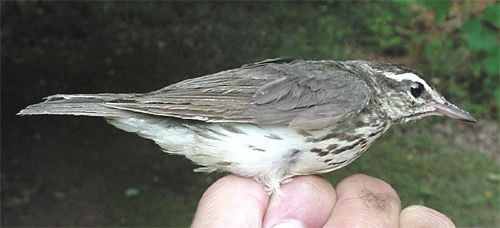 To the chagrin of beginning birders, the Northern Waterthrush has a congener--the Louisiana Waterthrush, S. motacilla--that is almost a dead-ringer. Louisiana Waterthrushes (above) have the same general markings, but a careful look will reveal some significant differences that can be used to separate the species in the field. Two of the most obvious--as shown in the side views abov--are that the Louisiana Waterthrush has a heavier bill and a nearly pure white eye line, while the Northern Waterthrush's eye line is usually somewhat buffy. In our experience, the breast and belly of the Louisiana Waterthrush are also whiter, while the Northern Waterthrush in the Carolinas often has a yellowish cast in those areas, but there are geographical variations in this characteristic. The Northern Waterthrush, with a wing chord of 67-82mm, also tends to be a bit smaller than the Louisiana, whose wing chord measures 72-87mm. Perhaps the most diagnostic morphological feature is the throat, which is streaked in the Northern Waterthrush (below left) but plain in its "southern cousin." 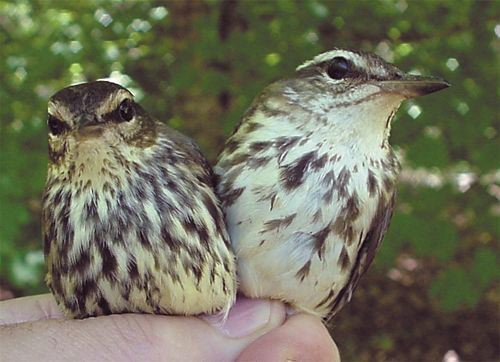 The Louisiana Waterthrush does indeed have a more southerly range, breeding only in the eastern half of the U.S. and mostly south of New York, Michigan and Wisconsin. Although the Louisiana Waterthrush supposedly breeds throughout the Carolinas, there are very few nesting records for the South Carolina Piedmont and almost none for the Coastal Plain. Here at Hilton Pond Center, we've caught several late spring and summer females with pronounced brood patches--including one this week--plus a few recent fledglings with tails only about half-grown. These birds are pretty strong evidence the species is breeding locally--perhaps at the base of a tree on the downstream side of the dam--but we've never been able to locate a nest.  . .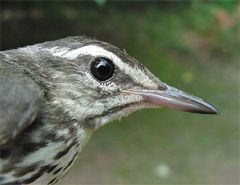 Since 1982, Northern Waterthrushes (above left) have been nearly ten times more common at Hilton Pond Center than Louisiana Waterthrushes (300 vs. 33). All the Northern Waterthrushes have been migrants banded in spring (15 April through 25 May) or fall (2 August through 29 September), and a couple of them have returned in later years. Tomorrow we're going out to beat the bushes again in search that elusive Louisiana Waterthrush nest--all in the hope of contributing the first confirmed breeding record for Hilton Pond Center AND for York County, South Carolina. If you enjoy "This Week at Hilton Pond," please help Support Hilton Pond Center for Piedmont Natural History. It's painless, and YOU can make a difference! You may wish to consult our Index of all nature topics covered since February 2000. |

